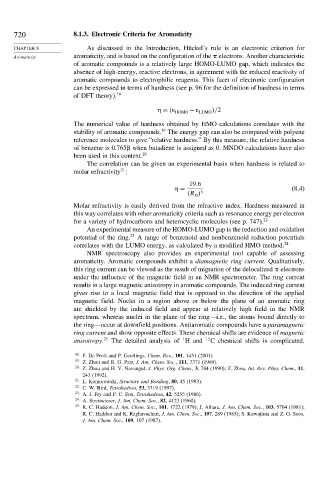Page 737 - Advanced Organic Chemistry Part A - Structure and Mechanisms, 5th ed (2007) - Carey _ Sundberg
P. 737
720 8.1.3. Electronic Criteria for Aromaticity
CHAPTER 8 As discussed in the Introduction, Hückel’s rule is an electronic criterion for
Aromaticity aromaticity, and is based on the configuration of the electrons. Another characteristic
of aromatic compounds is a relatively large HOMO-LUMO gap, which indicates the
absence of high-energy, reactive electrons, in agreement with the reduced reactivity of
aromatic compounds to electrophilic reagents. This facet of electronic configuration
can be expressed in terms of hardness (see p. 96 for the definition of hardness in terms
of DFT theory). 18
= HOMO − LUMO /2
The numerical value of hardness obtained by HMO calculations correlates with the
19
stability of aromatic compounds. The energy gap can also be compared with polyene
reference molecules to give “relative hardness.” By this measure, the relative hardness
of benzene is 0.765 when butadiene is assigned as 0. MNDO calculations have also
been used in this context. 20
The correlation can be given an experimental basis when hardness is related to
21
molar refractivity :
19 6
= (8.4)
R 3
D
Molar refractivity is easily derived from the refractive index. Hardness measured in
this way correlates with other aromaticity criteria such as resonance energy per electron
for a variety of hydrocarbons and heterocyclic molecules (see p. 747). 22
An experimental measure of the HOMO-LUMO gap is the reduction and oxidation
potential of the ring. 23 A range of benzenoid and nonbenzenoid reduction potentials
correlates with the LUMO energy, as calculated by a modified HMO method. 24
NMR spectroscopy also provides an experimental tool capable of assessing
aromaticity. Aromatic compounds exhibit a diamagnetic ring current. Qualitatively,
this ring current can be viewed as the result of migration of the delocalized electrons
under the influence of the magnetic field in an NMR spectrometer. The ring current
results in a large magnetic anisotropy in aromatic compounds. The induced ring current
gives rise to a local magnetic field that is opposed to the direction of the applied
magnetic field. Nuclei in a region above or below the plane of an aromatic ring
are shielded by the induced field and appear at relatively high field in the NMR
spectrum, whereas nuclei in the plane of the ring—i.e., the atoms bound directly to
the ring—occur at downfield positions. Antiaromatic compounds have a paramagnetic
ring current and show opposite effects. These chemical shifts are evidence of magnetic
1
anisotropy. 25 The detailed analysis of H and 13 C chemical shifts is complicated.
18
F. De Proft and P. Geerlings, Chem. Rev., 101, 1451 (2001).
19 Z. Zhou and R. G. Parr, J. Am. Chem. Soc., 111, 7371 (1989).
20
Z. Zhou and H. V. Navangul, J. Phys. Org. Chem., 3, 784 (1990); Z. Zhou, Int. Rev. Phys. Chem., 11,
243 (1992).
21 L. Komorowski, Structure and Bonding, 80, 45 (1993).
22
C. W. Bird, Tetrahedron, 53, 3319 (1997).
23
A. J. Fry and P. C. Fox, Tetrahedron, 42, 5255 (1986).
24 A. Streitwieser, J. Am. Chem. Soc., 82, 4123 (1960).
25
R. C. Haddon, J. Am. Chem. Soc., 101, 1722 (1979); J. Aihara, J. Am. Chem. Soc., 103, 5704 (1981);
R. C. Haddon and K. Raghavachari, J. Am. Chem. Soc., 107, 289 (1985); S. Kuwajima and Z. G. Soos,
J. Am. Chem. Soc., 109, 107 (1987).

